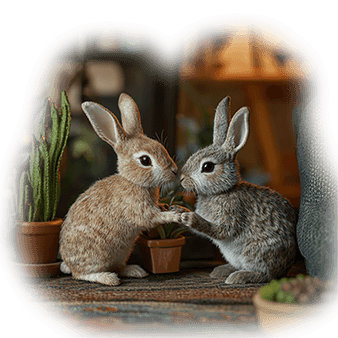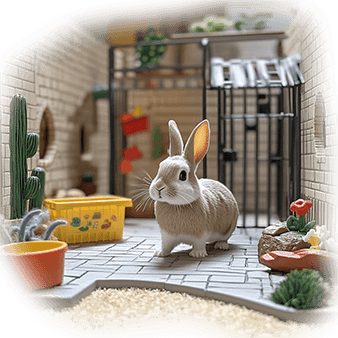Rabbits as Pets: A Guide to Their Lives, Habits, and Care

If you’re thinking about getting a rabbit as a pet, you’re in for a fun ride! Rabbits are adorable, social, and full of personality, but they also have unique needs that make them different from your typical cat or dog. In this post, we’ll explore everything about keeping a rabbit as a pet—from their sleeping and feeding habits to their activity levels, relationship with humans, and a few interesting facts to keep you entertained. Let’s hop right in!
Rabbit Basics: What They’re Like
Rabbits come in various shapes, sizes, and breeds, each with its unique personality. Some are cuddly and love being held, while others are more independent. What they all have in common is their inquisitive nature—they love to explore, hop around, and dig, so be prepared to give them plenty of space to do so. A rabbit’s lifespan ranges from 7 to 10 years, but with excellent care, some can live up to 12 or even 15 years!

Sleeping Habits
Unlike humans, rabbits are crepuscular—this means they are most active at dawn and dusk. During the day, you’ll find them napping in cozy spots around the house. And yes, rabbits do sleep with their eyes open! This is a survival instinct they developed in the wild to stay alert to potential predators. However, pet rabbits feel safer in their home environment and may close their eyes if they truly trust their surroundings.
Fun fact—Rabbits can sleep up to 8 hours a day, usually in small naps rather than one long stretch like us humans. They’re always ready for some hopping when the sun rises or sets.

Feeding Habits
Feeding rabbits isn’t as simple as tossing them some lettuce every now and then. Their diet is crucial to their health and needs to be carefully managed.
- Hay – This is the most important part of a rabbit’s diet. They need a constant supply of fresh hay to keep their digestive system moving smoothly and to help wear down their teeth, which grow continuously throughout their lives.
- Fresh Vegetables – Rabbits love leafy greens, such as romaine lettuce, parsley, cilantro, and dandelion greens. Avoid iceberg lettuce as it has little nutritional value.
- Pellets – Commercial rabbit pellets can provide extra nutrients, but they should make up only a small part of the diet.
- Water – Fresh water is essential, whether in a water bottle or a dish. Rabbits need hydration to stay healthy.
Rabbits also practice caecotrophy, which might sound strange, but it’s a natural process where they re-ingest special droppings (called cecotropes) to absorb more nutrients. While this sounds gross, it’s crucial for their digestive health.

Activity and Play
Rabbits are playful and energetic, especially during their active hours in the early morning and evening. They love to explore and need space to run and jump—this behavior is known as binkying, where they hop and twist in the air out of sheer joy. If your rabbit does this, it’s a sign they’re happy!
Toys are a great way to keep them engaged. They enjoy chewing on wooden blocks, cardboard tubes, and even digging in boxes filled with shredded paper. Just be sure to keep them away from wires and furniture—rabbits love to chew, and electrical cords can be dangerous.

Social Creatures
Rabbits are incredibly social animals. In the wild, they live in groups, so if you have a solo rabbit, it’s essential to spend a lot of time with them. Many rabbits form strong bonds with their humans and may follow you around, nudge you for attention, or even groom you (licking is a sign of affection in the rabbit world).
They do well with other rabbits, too—just be sure to introduce them properly. Bonded rabbits can become inseparable, playing together and even grooming each other.

Housing
Your rabbit needs a safe, spacious enclosure to call home, but they should also have access to a larger area where they can roam and stretch their legs. A large indoor cage or a bunny-proofed room is ideal. Make sure the flooring is soft to prevent sore hocks, a common issue for rabbits kept on wire-bottom cages.
And yes, rabbits can be litter-trained! With some patience, most rabbits can learn to use a litter box, making clean-up much easier for you.

Interesting Facts About Pet Rabbits
- They Communicate Without Sound – Rabbits have a range of body language cues. For example, if a rabbit thumps its hind legs, it’s a warning signal—either they’re scared or agitated. Tooth-clicking is their version of purring, showing they’re happy and content.
- Fast Learners – Rabbits can be trained to do tricks or respond to their names. Some owners even train their bunnies to jump through hoops or run obstacle courses.
- They Shed a Lot – Rabbits go through a shedding process called molting multiple times a year. You’ll need to brush them regularly, especially if you have a long-haired breed like the Angora rabbit.
- High-Impact on Bonding – Some rabbits bond so closely with their humans that they suffer from separation anxiety if left alone for too long. This is why it’s crucial to provide companionship, whether from another rabbit or regular human interaction.
- Rabbits’ Teeth Never Stop Growing – Their teeth grow continuously, which is why chewing on hay and wooden toys is so important to wear them down.

Final Thoughts
Owning a rabbit is incredibly rewarding. They’re quirky, social, and full of personality, but they do require a bit of work. From ensuring they have a proper diet, lots of space to explore, and plenty of mental stimulation, rabbits are wonderful companions for the right home.
If you’re willing to invest the time in understanding their needs, you’ll have a happy, healthy rabbit hopping around, bringing joy to your home.
Further reading: “The Everything Pet Rabbit Handbook: Your Ultimate Guide to Pet Rabbit Ownership, Training, and Care” (Amazon affiliate link) by Sarah Martin.
Affiliate Disclosure
This post may contain affiliate links, which means I earn from purchases made through links. Please see the privacy policy page for more details.






